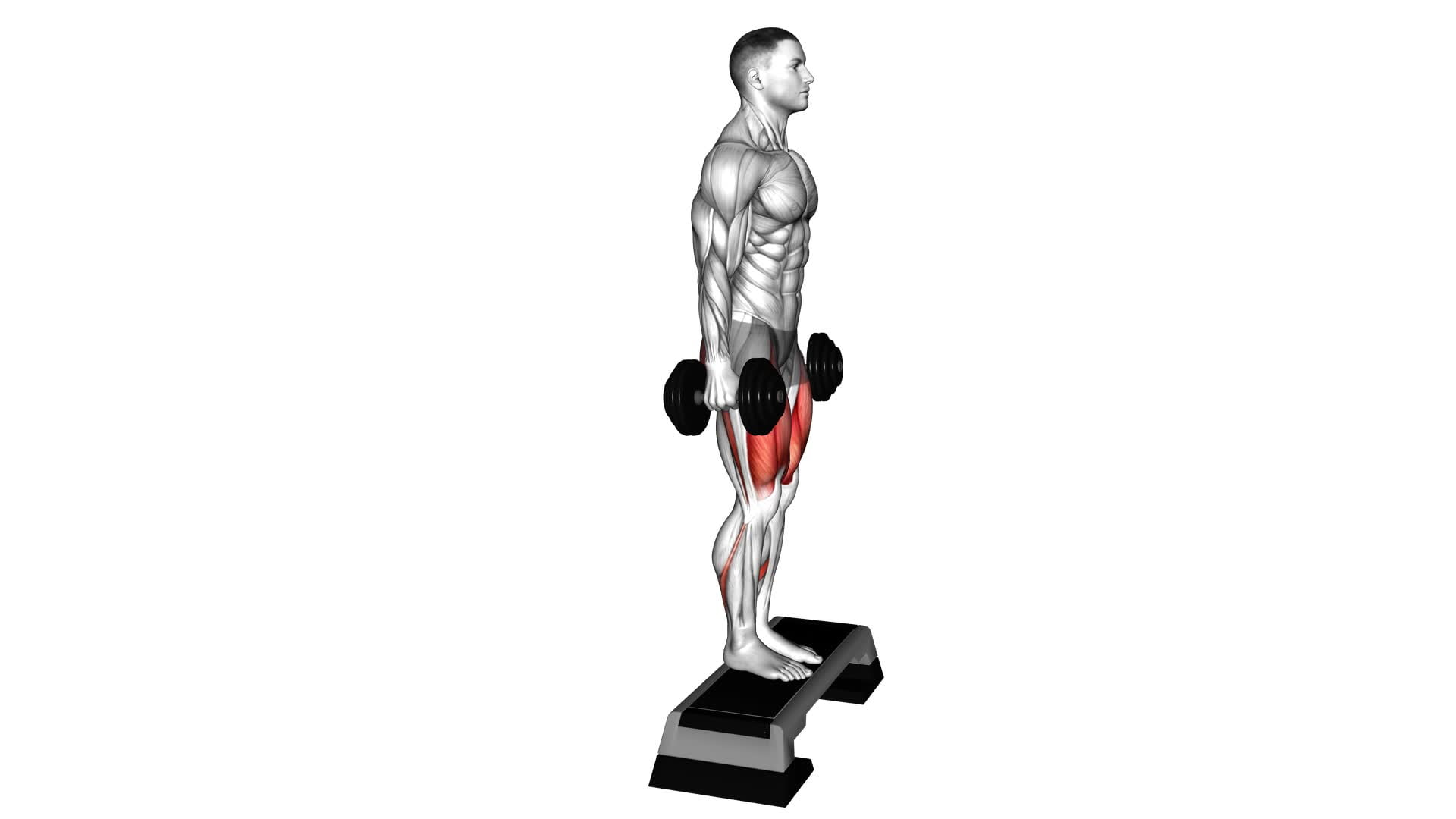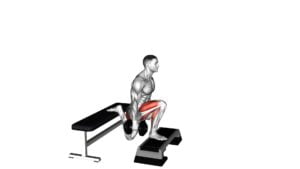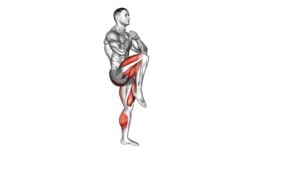Dumbbell Reverse Lunge From Deficit (Male) – Video Exercise Guide & Tips

Looking to level up your leg workout? Check out this video exercise guide for the dumbbell reverse lunge from deficit. You'll learn the proper form and technique to maximize results. Avoid common mistakes and try variations to challenge yourself.
Watch This Exercise Video
With this comprehensive guide and tips, you'll be able to target your lower body effectively and efficiently. Get ready to take your leg day to the next level with this challenging exercise.
Let's get started!
Key Takeaways
- The Dumbbell Reverse Lunge From Deficit targets multiple muscle groups including the quadriceps, hamstrings, glutes, and calves.
- This exercise provides greater activation compared to traditional lunges, making it more effective for building strength and muscle.
- Adding dumbbells to the exercise adds extra challenge and promotes muscle engagement.
- The Dumbbell Reverse Lunge From Deficit can be modified for different fitness levels and goals, making it suitable for a wide range of individuals.
Benefits of the Dumbbell Reverse Lunge From Deficit
When performing the Dumbbell Reverse Lunge From Deficit, you can experience a variety of benefits that will improve your lower body strength and stability. This exercise targets multiple muscle groups, including the quadriceps, hamstrings, glutes, and calves. One of the key advantages of doing the Dumbbell Reverse Lunge From Deficit is that it allows for greater activation of these muscle groups compared to traditional lunges. The use of dumbbells adds an extra challenge, promoting increased muscle engagement and overall strength development.
Additionally, the Dumbbell Reverse Lunge From Deficit can be modified to meet different fitness levels and goals. For beginners, performing the exercise without weights or using a lighter dumbbell can be a great starting point. As you progress and gain strength, you can gradually increase the weight to continue challenging your muscles.
Another benefit of this exercise is its impact on balance and stability. The deficit created by elevating your front foot forces your body to work harder to maintain balance, which in turn strengthens your stabilizing muscles. This helps improve your overall balance and coordination, reducing the risk of falls and injuries.
Proper Form and Technique for the Exercise
To perform the Dumbbell Reverse Lunge From Deficit with proper form and technique, you need to position yourself correctly. Start by standing with your feet hip-width apart and your dumbbells held at your sides. Take a step back with your right foot, ensuring your left knee is aligned with your left ankle. Lower your body until your left thigh is parallel to the ground, keeping your core engaged and your back straight. Push through your left heel to return to the starting position, and repeat on the other side.
To maximize results and avoid common mistakes, it's important to maintain proper form throughout the exercise. Avoid leaning your torso forward or rounding your shoulders. Keep your chest lifted and your gaze forward to ensure proper alignment. Additionally, make sure to fully extend your leg and engage your glutes as you push back up to the starting position. By focusing on these key elements, you'll be able to target your leg muscles effectively and minimize the risk of injury.
Now that you understand the proper form and technique for the Dumbbell Reverse Lunge From Deficit, let's move on to the equipment needed for the exercise.
Equipment Needed for the Exercise
Now let's talk about the essential equipment you'll need for this exercise.
Having the right equipment is crucial for ensuring proper form and maximizing your safety.
Additionally, we'll explore alternative options for those who may not have access to the required equipment.
Essential Equipment for Exercise
You will need three essential pieces of equipment for this exercise:
- Dumbbells: These will provide the resistance needed to challenge your muscles and make the exercise effective.
- Deficit platform: This elevated surface will allow you to perform the reverse lunge with a greater range of motion, targeting your muscles more effectively.
- Workout mat: This will provide cushioning and support for your joints and muscles, reducing the risk of injury.
Having the right exercise equipment and workout gear is crucial to ensure a safe and effective workout. In addition to the equipment mentioned above, it's important to consider safety considerations for equipment.
Safety Considerations for Equipment
When using the necessary equipment for the dumbbell reverse lunge from deficit exercise, it's important to consider safety considerations. Proper warm up is crucial before engaging in any exercise routine, including this one. This helps to prepare your muscles and joints for the movements involved, reducing the risk of injury.
Additionally, using the correct equipment is essential to minimize potential risks and injuries. Improper use of equipment can lead to accidents such as dropping weights, losing balance, or straining muscles. It's important to ensure that the dumbbells are securely held and that the deficit platform is stable.
Always follow proper form and technique, and if you're unsure about any aspect of the exercise or equipment, seek guidance from a qualified professional. Safety should always be a top priority in any workout routine.
Alternatives to Required Equipment
To ensure safety and effectiveness in your dumbbell reverse lunge from deficit exercise, it's important to consider alternatives to the required equipment. If you don't have access to dumbbells or a deficit, don't worry! There are still effective ways to work your legs and target the same muscles with bodyweight exercises.
Here are some alternatives to consider for your home workout:
- Bodyweight Reverse Lunges: Perform reverse lunges without any additional weight. This exercise still targets your quads, hamstrings, and glutes.
- Step-Ups: Find a sturdy step or platform and step up onto it, alternating legs. This exercise engages your leg muscles and provides a similar movement pattern to the dumbbell reverse lunge.
- Bulgarian Split Squats: Stand facing away from a bench or step and place one foot behind you on the elevated surface. Perform squats while keeping your front knee in line with your toes.
- Walking Lunges: Take a step forward with one leg and lower your body until both knees are bent at a 90-degree angle. Then, step forward with the opposite leg and repeat the movement.
Common Mistakes to Avoid
Avoid making these common mistakes during the dumbbell reverse lunge from deficit exercise to maximize your results.
Firstly, one common mistake to avoid is using too much weight. While it may be tempting to lift heavy, using weights that are too heavy can compromise your form and increase the risk of injury. It's important to choose a weight that challenges you, but still allows you to maintain proper form throughout the exercise.
Another mistake to avoid is rushing through the movement. The reverse lunge from deficit is a compound exercise that requires control and stability. Performing the movement too quickly can lead to loss of balance and reduce the effectiveness of the exercise. Take your time and focus on maintaining good posture and stability throughout each rep.
Additionally, it's crucial to avoid allowing your knee to extend past your toes during the lunge. This can put excessive strain on the knee joint and increase the risk of injury. Instead, focus on keeping your knee in line with your ankle as you descend into the lunge position.
Finally, make sure to avoid leaning forward or rounding your back during the exercise. This can put unnecessary stress on your lower back and compromise your form. Keep your chest up, shoulders back, and core engaged throughout the movement to maintain proper alignment.
Tips for Maximizing Results
To maximize your results with the dumbbell reverse lunge from deficit, it's important to focus on proper form techniques.
Make sure you maintain a straight back, keep your core engaged, and fully extend your legs during the movement.
Additionally, consistency and dedication are key. Aim to perform this exercise regularly and gradually increase the weight or difficulty level to continually challenge your muscles and see progress over time.
Proper Form Techniques
Maximize your results by focusing on proper form techniques when performing the dumbbell reverse lunge from deficit. To ensure you're getting the most out of this exercise, keep the following tips in mind:
- Maintain an upright posture throughout the movement to engage your core and prevent strain on your lower back.
- Step back far enough so that your front knee is directly above your ankle when in the lunge position.
- Keep your weight evenly distributed between your front and back legs to optimize balance and stability.
- Control your descent and avoid rushing through the exercise to fully engage your leg muscles and enhance strength gains.
By following these proper form techniques, you'll reduce the risk of injury and maximize the benefits of the dumbbell reverse lunge from deficit.
Consistency and Dedication
Stay committed and dedicated to your workout routine to maximize your results with the dumbbell reverse lunge from deficit.
Improving consistency and maintaining dedication are key factors in achieving your fitness goals. Consistency means regularly engaging in your workouts without skipping sessions or being sporadic. Make an effort to stick to your schedule and prioritize your fitness.
Dedication requires mental focus and determination. It means pushing yourself even when you don't feel like it and staying motivated throughout your fitness journey. Set realistic goals, track your progress, and celebrate your achievements along the way. Remember, results take time, so stay patient and trust the process.
Variations and Progressions to Try
Explore different variations and progressions to enhance your dumbbell reverse lunge from deficit exercise. By incorporating these variations into your routine, you can target specific muscle groups and challenge your body in new ways. Here are some variations and progressions to consider:
- Weighted Reverse Lunges: Hold heavier dumbbells in each hand to increase the resistance and intensity of the exercise.
- Jumping Reverse Lunges: Add a plyometric element to your lunges by jumping explosively between each lunge. This helps improve power and cardiovascular fitness.
- Curtsy Lunges: Instead of stepping straight back, cross one leg behind the other in a curtsy motion. This variation targets the glutes and inner thighs more effectively.
- Deficit Reverse Lunges: Perform the exercise with your back foot elevated on a step or platform. This increases the range of motion and adds an extra challenge to your balance and stability.
Remember to start with lighter weights and gradually increase the difficulty as you become more comfortable with each variation. Always maintain proper form and listen to your body to avoid injury.
Incorporating these variations and progressions won't only keep your workouts interesting but also help you achieve better results in your fitness journey.
Frequently Asked Questions
How Many Sets and Repetitions Should I Perform for the Dumbbell Reverse Lunge From Deficit?
To determine the number of sets and repetitions for the dumbbell reverse lunge from deficit, consider your fitness level and goals.
Start with 2-3 sets of 8-12 repetitions per leg and adjust as needed.
It's also beneficial to try different variations, such as using different weights or adding a pause at the bottom of the lunge.
Remember to listen to your body and gradually increase the intensity as you progress.
Can I Use a Barbell Instead of Dumbbells for This Exercise?
Yes, you can use a barbell as an alternative to dumbbells for the dumbbell reverse lunge from deficit exercise.
The dumbbell reverse lunge is a great exercise for targeting your legs and glutes while also improving balance and stability.
Using a barbell can provide a different challenge and allow you to increase the weight you're lifting.
Just make sure you maintain proper form and start with a weight that you can handle safely.
Should I Perform This Exercise on an Elevated Surface or on the Ground?
Performing the reverse lunge on an elevated surface offers several benefits. It increases the range of motion and strengthens your leg muscles more effectively.
However, if you prefer to perform the exercise on the ground, you can still reap the benefits by adding weights or increasing the number of reps.
Remember to maintain proper form and engage your core throughout the movement. Choose the option that challenges you without compromising your safety.
Can I Incorporate This Exercise Into My Lower Body Workout Routine?
Yes, you can definitely incorporate the dumbbell reverse lunge from deficit into your lower body workout routine.
This exercise offers several benefits compared to other exercises for lower body muscles.
It targets your glutes, hamstrings, and quads effectively, while also engaging your core for stability.
The deficit adds an extra challenge, helping to improve your balance and overall leg strength.
Is It Necessary to Warm up Before Performing the Dumbbell Reverse Lunge From Deficit?
Before performing the dumbbell reverse lunge from deficit, it's necessary to warm up. Warming up before exercise has several benefits, such as increasing blood flow to the muscles and reducing the risk of injury.
To maximize the effectiveness of this exercise, make sure to properly warm up your body with dynamic stretches and light cardio. This will help prepare your muscles for the workout and improve your overall performance.
Conclusion
In conclusion, the dumbbell reverse lunge from deficit is a highly effective exercise for strengthening and toning the lower body.
By properly executing the exercise and avoiding common mistakes, you can maximize your results and avoid injuries.
Additionally, trying variations and progressions can add variety to your workout routine and help you continue to challenge your muscles.
Incorporate this exercise into your fitness routine and reap the benefits of improved strength and stability.

Author
Years ago, the spark of my life’s passion ignited in my mind the moment I stepped into the local gym for the first time. The inaugural bead of perspiration, the initial endeavor, the very first surge of endorphins, and a sense of pride that washed over me post-workout marked the beginning of my deep-seated interest in strength sports, fitness, and sports nutrition. This very curiosity blossomed rapidly into a profound fascination, propelling me to earn a Master’s degree in Physical Education from the Academy of Physical Education in Krakow, followed by a Sports Manager diploma from the Jagiellonian University. My journey of growth led me to gain more specialized qualifications, such as being a certified personal trainer with a focus on sports dietetics, a lifeguard, and an instructor for wellness and corrective gymnastics. Theoretical knowledge paired seamlessly with practical experience, reinforcing my belief that the transformation of individuals under my guidance was also a reflection of my personal growth. This belief holds true even today. Each day, I strive to push the boundaries and explore new realms. These realms gently elevate me to greater heights. The unique combination of passion for my field and the continuous quest for growth fuels my drive to break new ground.



